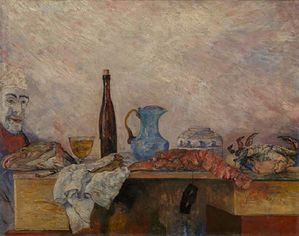| | BOOK FORMAT
Clth, 8.25 x 12.5 in. / 136 pgs / 151 color. PUBLISHING STATUS
Pub Date 2/28/2014
Out of stock indefinitely DISTRIBUTION
D.A.P. Exclusive
Catalog: SPRING 2014 p. 56 PRODUCT DETAILS
ISBN 9783775737227 TRADE
List Price: $60.00 CAD $79.00 AVAILABILITY
Not available | TERRITORY
NA LA | EXHIBITION SCHEDULEBasel, Switzerland
Kunstmuseum Basel, 02/16/14-05/25/14 | | THE FALL 2025 ARTBOOK | D.A.P. CATALOG  | | Preview our FALL 2025 catalog, featuring more than 500 new books on art, photography, design, architecture, film, music and visual culture.
|
| | | James EnsorFrom the Royal Museum of Fine Arts Antwerp and Swiss CollectionsEdited by Anne-Birgitte Fonsmark, Nina Zimmer. Text by Herwig Todts, Nina Zimmer.
 Phantoms, skulls, skeletons and other macabre figures populate the paintings, drawings and prints of James Ensor. His works are bizarre, ironic, occasionally belligerent and provocative, but always buoyed by a keen sense of humor, and his nightmarish motifs reveal the absurd and grotesque about everyday life. Ensor’s interests were wide-ranging; he was as enthusiastic about Rembrandt’s prints as he was about the Belgian Carnival festival and Japanese masks. In turn, early twentieth-century artists such as Alfred Kubin, Paul Klee and the German Expressionists Emil Nolde and Ernst Ludwig Kirchner were inspired by his creative power and radical rejection of traditional European ideals of beauty. This volume presents nearly 60 paintings and an equal number of drawings, which are published here for the first time. Phantoms, skulls, skeletons and other macabre figures populate the paintings, drawings and prints of James Ensor. His works are bizarre, ironic, occasionally belligerent and provocative, but always buoyed by a keen sense of humor, and his nightmarish motifs reveal the absurd and grotesque about everyday life. Ensor’s interests were wide-ranging; he was as enthusiastic about Rembrandt’s prints as he was about the Belgian Carnival festival and Japanese masks. In turn, early twentieth-century artists such as Alfred Kubin, Paul Klee and the German Expressionists Emil Nolde and Ernst Ludwig Kirchner were inspired by his creative power and radical rejection of traditional European ideals of beauty. This volume presents nearly 60 paintings and an equal number of drawings, which are published here for the first time.
James Ensor (1860–1949) was born in Brussels where he studied at the Académie Royale des Beaux-Arts. He first exhibited his work in 1881, and received his first solo exhibition four years later. Despite initial attacks in the press, Ensor quickly found favor in his native Belgium. By 1920 he was the subject of major exhibitions; in 1929 he was named a baron by King Albert; and in 1933 he was awarded the Légion d’honneur. Ensor rarely left Belgium, and endeared himself to the people of Ostend, where he spent most of his life, as a familiar figure about town.
"Mask Looking at Crustaceans" (1891) is reproduced from James Ensor. |
|  | STATUS: Out of stock indefinitely. | |
| | | |
| |
| |

|
FORMAT: Clth, 8.25 x 12.5 in. / 136 pgs / 151 color.
LIST PRICE: U.S. $60.00
LIST PRICE: CANADA $79
ISBN: 9783775737227
PUBLISHER: Hatje Cantz
AVAILABLE: 2/28/2014
DISTRIBUTION: D.A.P.
RETAILER DISC: TRADE
PUBLISHING STATUS: Out of stock indefinitely
AVAILABILITY: Not available
TERRITORY: NA LA | D.A.P. CATALOG: SPRING 2014 Page 56 | PRESS INQUIRIES
Tel: (212) 627-1999 ext 217
Fax: (212) 627-9484
Email Press Inquiries: publicity@dapinc.com | TRADE RESALE ORDERS
D.A.P. | DISTRIBUTED ART PUBLISHERS
Tel: (212) 627-1999
Fax: (212) 627-9484
Customer Service: (800) 338-2665
Email Trade Sales: orders@dapinc.com |
| James Ensor
From the Royal Museum of Fine Arts Antwerp and Swiss Collections Published by Hatje Cantz.
Edited by Anne-Birgitte Fonsmark, Nina Zimmer. Text by Herwig Todts, Nina Zimmer. Phantoms, skulls, skeletons and other macabre figures populate the paintings, drawings and prints of James Ensor. His works are bizarre, ironic, occasionally belligerent and provocative, but always buoyed by a keen sense of humor, and his nightmarish motifs reveal the absurd and grotesque about everyday life. Ensor’s interests were wide-ranging; he was as enthusiastic about Rembrandt’s prints as he was about the Belgian Carnival festival and Japanese masks. In turn, early twentieth-century artists such as Alfred Kubin, Paul Klee and the German Expressionists Emil Nolde and Ernst Ludwig Kirchner were inspired by his creative power and radical rejection of traditional European ideals of beauty. This volume presents nearly 60 paintings and an equal number of drawings, which are published here for the first time.
James Ensor (1860–1949) was born in Brussels where he studied at the Académie Royale des Beaux-Arts. He first exhibited his work in 1881, and received his first solo exhibition four years later. Despite initial attacks in the press, Ensor quickly found favor in his native Belgium. By 1920 he was the subject of major exhibitions; in 1929 he was named a baron by King Albert; and in 1933 he was awarded the Légion d’honneur. Ensor rarely left Belgium, and endeared himself to the people of Ostend, where he spent most of his life, as a familiar figure about town.
| VIEW MORE ONLINE AT: https://www.artbook.com/9783775737227.html |
| | |
|
